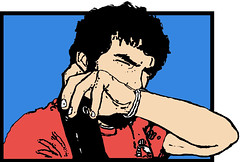Back in feudal Japan, ninjas were revered warriors whose functions included espionage, sabotage, infiltration, and assassination. Unfortunately, career prospects dried up for Ninjas in the 1600's due to the unification of Japan under the Tokugawa shogunate. Today, job prospects for Ninjas are slim.
Viewing entries in
Employee Engagement
A great team deserves great coffee, according to Nespresso - but will it drive employee engagement? Unfortunately, it's not that easy. Employee Engagement is one of the least understood and most exploited terms in Human Resources today.

In Emotional Contagion in the Workplace - Part I, I wrote about the existence of patterns that can affect productivity in ways that can’t be accurately forecast, and that emotional contagion is one of these patterns. In research published in 2010, researchers from Harvard formally demonstrated that emotions can be thought of as infectious diseases spreading across social networks, including at work. The study looked at being "content" and "discontent" as two viruses, and found that these emotions could be "caught" from others in the social network. Key findings of the research include:
- It was possible for individuals to spontaneously become infected (this happens more often for positive emotions);
- Like a biological virus, individuals would return to a neutral (non-infected) state after the virus had run its' course (though this could take years).
- Negative emotions (discontent) are twice as contagious as Positive emotions (content); but recovery is twice as fast - so on balance, the rates of discontent and content tend to be about the same in a population.
- It's also possible to have a "superinfection", where someone who is discontent catches the content virus; or vice-versa.
This research has significant implications for workplaces. Many studies have focused on the link between happiness and productivity - according to one, "happier workers were 12% more productive. Unhappier workers were 10% less productive." (source) So what happens when happiness and unhappiness go viral at work? Even with the same headcount, you get wild fluctuations in output. Below is a very simple viral contagion model. At the start, there are equal numbers of happy and unhappy workers (1 in 9); and the bulk of the employees are in a neutral state (78%). The unpredictable nature of emotional contagion has some interesting effects:
(Video Removed)
Because of the randomness / chance of the interactions, every time you run a simulation you get a different scenario - and because of the contagion aspect, these differences can be significant, even within the same scenario. If you overlay the figures for productivity; the productivity difference between these scenarios is significant. The result is that it's difficult to accurately predict output from a workforce over time, even if your hiring and retention rates are constant - and that's just one of the reasons why workforce planning that focuses on headcount planning alone is of limited value.
The good news is that there are actions you can take to boost employee happiness in your organisation, and minimise the fallout of the viral contagion of negative emotions. In part III I'll be writing about some of the ways you boost productivity, even if you can't predict it.
Related articles
- Emotional Contagion in the Workplace - Part I (workforceplanning.wordpress.com)
- TEDx Thessaloniki: The Power of Positivity (slideshare.net)
- The "Rotten Apple" Effect Happens in Herds of Cows Too (bobsutton.typepad.com)

Much of the work we do in Strategic Workforce Planning involves taking both internal and external trends, and determining how they might play out for your organisation. Once you've done that, you can determine tactics to harness or address these trends to prepare for the best possible future workforce.
Sometimes, there are clear trends happening inside the organisation that are unsustainable - high performers turning over, key skills being lost, etc. Identifying those trends through workforce analytics lets you understand the nature and extent of the problem, and determine strategies for addressing them. By targeting these initiatives to where you need them most, you can ensure that your HR and Talent Management strategies are effective and efficient.
On the other side of the coin, workforce analytics and environment scanning help you to recognise opportunities and areas that the organisation is doing well in, so that you can capitalise on those. People who are trained in a particular skillset are 20% more productive? There's your ROI for the training initiative right there.
One of the key things to recognise in any kind of workforce futuring is that it's not just about headcount - you need to take into account the skillset and the productivity of the workforce too... and some trends can effect productivity in ways that just can't be predicted. Key among these is engagement. The good news is that engagement (like many emotions in the workplace) is contagious. The bad news is that disengagement is twice as contagious. Further, trends that are subject to "contagion" have multiplier effects that can't be accurately forecast. In a coming post, I'll be talking about the research that supports emotional contagion in the workplace, the implications of this, and what you can do about it. Stay tuned.
Related articles
- The ROI of Talent Management Programmes (workforceplanning.wordpress.com)
- Emotional Contagion in the Workplace - Part II (workforceplanning.wordpress.com)
Bellagio Carpet
Does Las Vegas have anything to teach Employers about employee engagement?
I've recently been reading about "flow", a state of extreme focus and productivity - and the lengths that Las Vegas casinos will go to in encouraging it. This got me thinking about how Flow could be applied to the workplace, and whether Las Vegas has anything to teach employers about it.
Flow is the concept of intrinsically motivated activity - activity that is in itself rewarding, regardless of the outcome of that activity. In this 2002 article, Flow is described as having these characteristics:
- Intense and focused concentration on what one is doing in the present moment
- Merging of action and awareness
- Loss of reflective self-consciousness (i.e., loss of awareness of oneself as a social actor)
- A sense that one can control one's actions; that is, a sense the one can in principle deal with the situation because one knows how to respond to whatever happens next
- Distortion of temporal experience (typically, a sense that time has passed faster than normal)
- Experience of the activity as intrinsically rewarding, such that often the end goal is just an excuse for the process.
Productivity requires the right balance between challenge and skill
It takes the right combination of skill and challenge to achieve flow. Too much challenge for the individuals' skill level, and the result is anxiety. Too much skill for the challenge level, and the result is boredom. Of course, those who are highly both skilled and highly challenged perform the best - which might explain why A Players are widely cited as being many multiple times more productive than B Players. For example in this article, Steve Jobs is quoted as saying:
Now, in software, and it used ot be the case in hardware, the difference between the average software developer and the best is 50:1; Maybe even 100:1
HR professionals might think of flow in employees as extreme engagement and productivity. Casinos think of it in its' customers as extremely profitable, and "encouraging flow" in Vegas is big business. For example, the casinos use some of these tricks - some more applicable to the workplace than others:
Regular Feedback
Lights and sounds provide gamblers with regular feedback on how they are performing. This motivates them to continue. It's easy to imagine how this one can be incorporated into the workplace.
Recognition
The occasional free ticket or meal makes visitors to the casinos feel valued and important. In many cases, the payoff in loyalty is much greater than the cost of the gift - in casinos as in workplaces, people get a boost of motivation from recognition and a sense of achievement.
The Physical Environment
Ugly Carpet
The psychadelic carpets in Vegas give a sense of the surreal, encouraging the distortion of temporal experience, one of the conditions of "flow".
Getting rid of the clocks and windows
Vegas casino's don't have clocks or windows - again, the distortion of temporal experience and losing sense of time.
Scents
When a casino in Las Vegas pumped a pleasant but unidentifiable scent into a slot-machine area on a Saturday, the machines raked in about 50 percent more money than on the previous or following Saturday. Elsewhere it's been suggested that pumping pheremones into the air encourages people to gamble more aggressively
Music
Music can help to encourage people into a trance-like state. Casinos use this to great effect, and it's been reported elsewhere that some casinos even use different music in the same elevator depending on whether you're going up or down to regulate mood.
Challenge matching the Skill
As mentioned above, flow happens when a the challenge and the skill are in synch - if these are out of balance, then boredom or anxiety are the end results.
The casinos in Las Vegas spend a lot of time and money researching these conditions to encourage "flow" - and I wonder if there are any of these concepts that we can apply to workplaces. After all, if "Flow" is the secret to happiness as Csikszentmihalyi claims, then setting the work environment up to maximise the chance of flow makes for both happy and productive workers. Are there any other factors you can think of to encourage "flow" in the workplace?
Related articles
- The Secret to a Sustainable Workplace Culture (steveniwersen.typepad.com)
- Csikszentmihalyi : Ah-ha moment (s00084172.wordpress.com)









